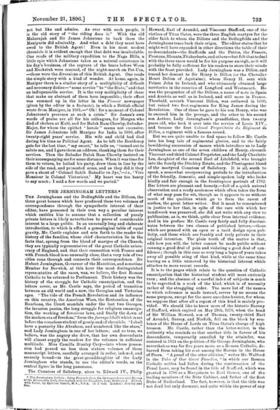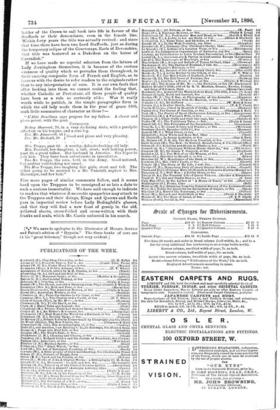THE JERNINGHAM LETTERS.*
Tax Jerninghams and the Bedingfelds and the Dillons, the three great houses which have produced these two volumes of correspondence through the sympathetic interest of their editor, have possessed in their own way a peculiar interest which entitles him to assume that a collection of purely private letters is likely nevertheless to prove of considerable interest to a large public. In an unusually long and elaborate introduction, to which is affixed a genealogical table of equal gravity, Mr. Castle explains and sets forth to the reader the history of the families, whose chief characteristics lie in the facts that, sprung from the blood of martyrs of the Church, they are typically representative of the great Catholic aristo- cracy of England, and that their connection with France and with French blood is so unusually close, that a very tale of two cities runs through and connects their correspondence. Sir Hubert Jerningham, Governor of the Mauritius, and sometime Member for Berwick, at this hoar the most distinguished representative of the races, was, we believe, the first Roman Catholic to be returned to Parliament. Their history was the history of the struggle for Catholic emancipation, and the letters cover, as Mr. Castle says, the period of transition between an old world and a new, the Georgian and Victorian ages. "The tide of the French Revolution and its influence on this country, the American Wars, the Restoration of the Bourbons, the Court scandals under the last two Georges, the invasion panics, the long struggle for religious emancipa- tion, the working of ferocious laws, and finally the dawn of the modern era of freedom," form the farrago libelli which is set before the voracious student of gossip and of chronicle. "I shall have a posterity like Abraham, and numbered like the stars," said Lady Jerningham in one of her letters; and so true, we believe, was the augury she drew, that her own descendants will almost supply the readers for the volumes in sufficient multitude. Miss Camilla Stanley Cary—into whose posses- sion had passed no less than sixteen volumes of these manuscript letters, carefully arranged in order, indexed, and securely bound—is the great-granddaughter of the Lady Jerningham who stands, to use the editor's words, as the central figure in the long panorama.
The Countess of Salisbury, niece to Edward IV., Philip
• The Jerningham Letters : being Excerpts from the Correspondence and Diaries of the Honourable Lady Jerningham and her Daughter, Lady Bedinyfeld. with lioteP, by Egerton Castle, M.A., F.B.A. In 2 Tots. London: Bentley sad
Eon.
Howard, Earl of Arundel, and Viscount Stafford, one of the victims of Titus Oates, were the three English martyrs for the older faith to whom the Dillons and the Bedingfelds and the Jerninghams trace back their origin. The editor states that be might well have expanded in other directions the table of their co-descendants—the Staffords and the Petres, the Frasers, Prestons, Blonnts, Fitzherberts, and others—but felt that to deal with the three races would be for his purpose enough, as it will probably be folly sufficient for his readers to store their minds with the feast provided. Lady Jerningham was a Dillon, and traced her descent to Sir Henry le Dillon (or the Chevalier Henri Delion of Aquitaine), whom Henry II. sent with Prince John to Ireland, and who ultimately obtained large territories in the counties of Longford and Westmeath. He was the progenitor of all the Dillons, a, name of note in Spain and Austria as well as in Ireland, and still more in France.
Theobald, seventh Viscount Dillon, was outlawed in 1690`
but raised two foot-regiments for King James during the Revolution. One of these he gave to his son Henry, who was
to succeed him in the peerage, and the other to his second son Arthur, Lady Jeruingham's grandfather, then twenty years old, who took it over into the service of Louis XIV., and became the first Colonel Proprietaire du Regiment de Dillon, a regiment with a famous record.
But we are quite unable to find space to follow Mr. Castle into his long tale of regimental glories, and to the fairly bewildering succession of names which introduce us to Lady Jerningham as one of the seven children of Henry, eleventh Viscount and third Colonel Proprietor, and the Lady Charlotte Lee, daughter of the second Earl of Litchfield, who brought into the family the Ditchley Estate, and the Plantagenet blood of the martyred Countess of Salisbury. It is all, sooth to speak, a somewhat overpowering prelude to the introduction
of the friendly, domestic, and simple-spoken lady who looks kindly and fair enough in the frontispiece portrait of ma
Her letters are pleasant and homely,—full of a quick natural observation and a ready acuteness which often takes the form of what may pass for wit, though as it appears to us without much of the qualities which go to form the rarest of scribes, the great letter-writer. But it must be remembered in justice to her that, in spite of the care with which her handiwork was preserved, she did not write with any view to publication, as is, we think, quite clear from internal evidence. And in his preface Mr. Castle very fairly and fully discrimi- nates between the two classes of published letters,—those which are penned with an open or a tacit design upon pub- licity, and those which are frankly and truly private in their original intention. The plain truth of the matter is that, edit how you will, the latter cannot be made publics without causing a good deal of pain and violating a good deal of con• fidence ; though in this case so very long a lapse of years takes away all possible sting of that kind, while at the same time leaving us a little unmoved by the historical interest which attaches to more recent records.
It is to the pages which relate to the question of Catholic emancipation that the historical student will most curiously
turn ; and the absence of a careful index of subjects is much to be regretted in a work of the kind, which is of necessity rather of the straggling order. The mere list of the names to which reference is made instead, serves by no means the same purpose, except for the mere anecdote-bunter, for whom we suppose that after all a repast of this kind is mainly pro- vided. We should like to know more of the historic Barony of Stafford, which expired on May 29th, 1678, when the head of Sir William Howard, son of Thomas, twenty-third Earl of Arundel, Surrey, and Norfolk, fell on the block by nen. tence of the House of Lords on Titus Oates's charge of high treason. Mr. Castle, rather than the letter-writer, is the• authority who reminds us that another title in favour of hirs descendants, temporarily annulled by the attainder, was restored in 1824 on the petition of Sir George Jerningham, who nevertheless was for five years more, as a Roman Catholic, de- barred from taking his seat among the Barons in the House of Peers. "A proof of the utter oblivion," writes Mr. Walton in the Tales of Our Great Families, " in which our Roman Catholic nobles had fallen during the continuation of the Penal Laws, may be found in the title of Stafford, which was granted in 1786 as a Marquisate to Earl Gower, one of the- leading members of the Bute Cabinet, and father of the first, Duke of Sutherland. The fact, however, is that the title was not dead but only dormant, and quite within the power of any
holder of the Crown to call back into life in favour of the Staffords or their descendants, even in the female line. Within forty years the title was actually revived : and since that time there have been two Lord Staffords, just as during the temporary eclipse of the Courtenays, Earls of Devonshire, that title was bestowed as a Dukedom on the house of Cavendish."
If we have made no especial selection from the letters of Lady Jerningham themselves, it is because of the curious evenness of quality which so pervades them throughout, in their amazing composite form of French and English, as to leave us with the desire to refer readers to the originals rather than to any interpretation of ours. It is our own fault that after looking into them we cannot resist the feeling that, whether Catholic or Protestant, all these people of quality have been as a rule so curiously alike. Was it really worth while to publish, in the simple paragraphic form in which the old lady made them in the year of grace 1808, such little summaries of character as these ?— "L'Abbe Dourtians says prayers for my father. A clever and pious priest, with the gout.
CATHOLICS.
Bishop Bharrock, 70, in a very declining state, with a paralytic affection on his tongue, and a sore leg.
Rev. Mr. Ainsworth. 441
j Good and pious and very pleasing. Rev. Mr. Birdsall, 38 Mrs. Trapps, past GO. A worthy, delicate-looking old lady.
Mrs. Tunstall, her daughter, a tall, stout, well-looking person, past 40, a great talker. Her husband in America. She hopes to join him. They have been unfortunate in speculation. Two Mr. Trapps, the sons, both in the Army. Good natured, tut neither well-looking nor smart. The Miss Trapps, two laughing fair girls, stout and tall. The eldest going to be married to a Mr. Tunstall, nephew to Mrs. Messenger, and her heir."
Five more pages of similar comments follow, and it seems hard upon the Trappses to be consigned at so late a date to such a curious immortality. We have said enough to indicate to readers that whatever democratic sympathies may attach to the Trappses and their doings, Kings and Queens and Earls pass in impartial review before Lady Bedingfeld's glasses, and that they will find a new feast of gossip in the old, yellowed sheets, cross-folded and cross-written with their franks and seals, which Mr. Castle unburied in his search.























































 Previous page
Previous page